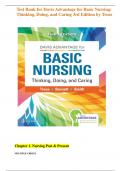Test Bank for Davis Advantage for Basic Nursing:
Thinking, Doing, and Caring 3rd Edition by Treas
Chapter 1. Nursing Past & Present
MULTIPLE CHOICE
,1. Which is the most influential factor that has shaped the nursing profession?
1) Physicians’ need for handmaidens
2) Societal need for healthcare outside the home
3) Military demand for nurses in the field
4) Germ theory influence on sanitation
ANS: 3
Chapter number and title: 1, Nursing Past & Present
Chapter learning objective: Define nursing in your own words.
Chapter page reference: p. 7
Heading: Historical Context of Nursing
Integrated Processes: Teaching and Learning
Client Need: Safe and Effective Care Environment: Management of Care
Cognitive level: Comprehension [Understanding]
Concept: Professionalism
Difficulty: Easy
Feedback
1 The physician's handmaiden was/is a nursing stereotype rather than an influence
on nursing.
2 Although there has been a need for healthcare outside the home throughout
history, this has more influNence on the development of hospitals than on
nursing; this need provided one more setting for nursing work.
3 Throughout the centuries, stability of the government has been related to the
success of the military to protect or extend its domain. As the survival and
well-being of soldiers are both critical, nurses provided healthcare to the sick
and injured at the battle site.
4 Germ theory and sanitation helped to improve healthcare but did not shape
nursing.
PTS: 1 CON: Professionalism
2. Which is an example of an illness-prevention activity?
1) Encouraging the use of a food diary
2) Joining a cancer support group
3) Administering immunization for HPV
4) Teaching a diabetic patient about his diet
ANS: 3
Chapter number and title: 1, Nursing Past & Present
Chapter learning objective: Name and recognize the four purposes of nursing care.
Chapter page reference: p. 15
Heading: Nursing Practice: Caring for Clients
Integrated Processes: Nursing Process – Implementation
Client Need: Health Promotion and Maintenance
, Cognitive level: Application [Applying]
Concept: Health Promotion
Difficulty: Moderate
Feedback
1 Illness-prevention activities focus on avoiding a specific disease. A food diary is
a health-promotion activity.
2 Although cancer is a disease, it is assumed that a person joining a support group
would already have the disease; therefore, this is not disease prevention but
treatment.
3 Administering immunization for HPV is an example of illness prevention.
4 Teaching a diabetic patient about diet is a treatment for diabetes; the patient
already has diabetes, so it cannot prevent diabetes.
PTS: 1 CON: Health Promotion
3. Which contribution of Florence Nightingale had an immediate impact on improving patients’
health?
1) Providing a clean environment
2) Improving nursing education
3) Changing the delivery of care in hospitals
4) Establishing nursing as a distinct profession
ANS: 1
Chapter number and title: 1, Nursing Past & Present
Chapter learning objective: Name nine expanded roles for nursing.
Chapter page reference: p. 9
Heading: Table 1-1 Roles and FNunctions of the Nurse
Integrated Processes: Caring
Client Need: Health Promotion and Maintenance
Cognitive level: Comprehension [Understanding]
Concept: Evidence-Based Practice
Difficulty: Easy
Feedback
1 Improved sanitation (a clean environment) greatly and immediately reduced the
rate of infection and mortality in hospitals.
2 This is an activity of Florence Nightingale that improved healthcare or nursing,
but the impact is long range, not immediate.
3 This is an activity of Florence Nightingale that improved healthcare or nursing,
but the impact is long range, not immediate.
4 This is an activity of Florence Nightingale that improved healthcare or nursing,
but the impact is long range, not immediate.
PTS: 1 CON: Evidence-Based Practice
4. Which aspect of the full-spectrum nursing role is essential for the nurse to do in order to
successfully carry out all the others?
1) Thinking and reasoning about the client’s care
2) Providing hands-on client care
3) Carrying out physician orders
, 4) Delegating to assistive personnel
ANS: 1
Chapter number and title: 1, Nursing Past & Present
Chapter learning objective: Name and recognize the four purposes of nursing care.
Chapter page reference: p. 8
Heading: Nursing Today: Full-Spectrum Nursing
Integrated Processes: Nursing Process
Client Need: Safe and Effective Care Environment: Management of Care
Cognitive level: Analysis [Analyzing]
Concept: Patient-Centered Care
Difficulty: Difficult
Feedback
1 A substantial portion of the nursing role involves using clinical judgment,
critical thinking, and problem solving, which directly affect the care the client
will actually receive.
2 Providing hands-on care is important; however, clinical judgment, critical
thinking, and problem-solving are essential to do it successfully.
3 Carrying out physician orders is a small part of a nurse’s role; it, too, requires
nursing assessment, planning, intervention, and evaluation.
4 Many simple nursing tasks are being delegated to nursing assistive personnel;
delegation requires careful analysis of patient status and the appropriateness of
support personnel to deliver care.
PTS: 1 CON: Patient-Centered Care
5. Which statement pertaining to N
B enner’s practice model for clinical competence is true?
1) Progression through the stages is constant, with most nurses reaching the proficient
stage.
2) Progression through the stages involves continual development of thinking and
technical skills.
3) The nurse must have experience in many areas before being considered an expert.
4) The nurse’s progress through the stages is determined by years of experience and
skills.
ANS: 2
Chapter number and title: 1, Nursing Past & Present
Chapter learning objective: Discuss the transitions nursing education has undergone in the last
century.
Chapter page reference: p. 12
Heading: Benner’s Model
Integrated Processes: Caring
Client Need: Safe and Effective Care Environment: Management of Care
Cognitive level: Comprehension [Understanding]
Concept: Evidence-Based Practice
Difficulty: Easy
Feedback
1 Movement through the stages is not constant.
2 Benner’s model is based on integration of knowledge, technical skill, and
intuition in the development of clinical wisdom.





